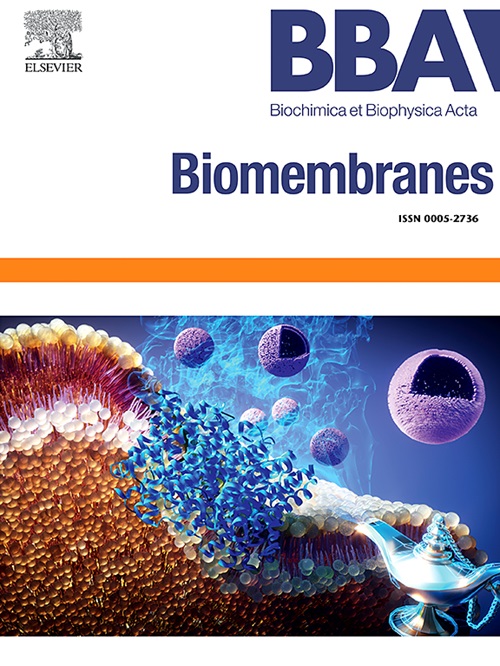A simulation analysis of the effect of a cholesterol-dependent fusogenic peptide from HIV gp41 on membrane phospholipid dynamics
IF 2.5
3区 生物学
Q3 BIOCHEMISTRY & MOLECULAR BIOLOGY
引用次数: 0
Abstract
CpreTM is a fusogenic peptide whose N-terminal portion is derived from the membrane-proximal external region (MPER) and C-terminal portion covers the transmembrane (TM) domain of gp41 of HIV. CpreTM has been shown to induce membrane fusion, which requires cholesterol molecules as membrane components. To gain insight into the effects of CpreTM on membrane lipid dynamics, we performed molecular dynamics simulations. In conventional simulations, several cholesterol-binding sites were found under the segment derived from MPER and near the cholesterol recognition/interaction amino acid consensus (CRAC) motif located at the C-terminus of MPER. CpreTM resides in shallower positions in the POPC (palmitoyl oleoyl phosphatidylcholine)/cholesterol bilayer than in the pure POPC bilayer. Our metadynamic simulations using the position of one POPC molecule (“target POPC”) as the collective variable showed that CpreTM remarkably lowered the free energy cost for the POPC protrusion from the cholesterol-containing membrane; e.g., the cost for 0.7 nm outward displacement from the height of bulk POPC molecules was decreased by ~10 kJ/mol compared to the peptide-free corresponding system. Such stabilization of the POPC protrusion was not observed in the cholesterol-free POPC membrane. It was more pronounced near the aromatic residues, including the three Trp residues of CpreTM, suggesting important roles for aromatic residues in stabilizing the POPC protrusion.

HIV gp41中胆固醇依赖性融合原肽对膜磷脂动力学影响的模拟分析。
CpreTM是一种融合原肽,其n端部分来源于膜近端外区(MPER), c端部分覆盖HIV的gp41的跨膜(TM)结构域。CpreTM已被证明可以诱导膜融合,这需要胆固醇分子作为膜组分。为了深入了解CpreTM对膜脂动力学的影响,我们进行了分子动力学模拟。在常规模拟中,在MPER衍生的片段下和位于MPER c端的胆固醇识别/相互作用氨基酸共识(CRAC)基序附近发现了几个胆固醇结合位点。与纯POPC双分子层相比,CpreTM在棕榈酰油酰磷脂酰胆碱/胆固醇双分子层中的位置较浅。我们使用一个POPC分子(“目标POPC”)的位置作为集体变量的元动力学模拟表明,CpreTM显著降低了POPC从含胆固醇膜中突出的自由能成本;例如,与无肽的相应体系相比,从体POPC分子高度向外位移0.7 nm的成本降低了~10 kJ/mol。在无胆固醇的POPC膜中没有观察到这种稳定的POPC突出。在芳香残基(包括CpreTM的三个Trp残基)附近更为明显,提示芳香残基在稳定POPC突出中起重要作用。
本文章由计算机程序翻译,如有差异,请以英文原文为准。
求助全文
约1分钟内获得全文
求助全文
来源期刊

Biochimica et biophysica acta. Biomembranes
生物-生化与分子生物学
CiteScore
8.20
自引率
5.90%
发文量
175
审稿时长
2.3 months
期刊介绍:
BBA Biomembranes has its main focus on membrane structure, function and biomolecular organization, membrane proteins, receptors, channels and anchors, fluidity and composition, model membranes and liposomes, membrane surface studies and ligand interactions, transport studies, and membrane dynamics.
 求助内容:
求助内容: 应助结果提醒方式:
应助结果提醒方式:


